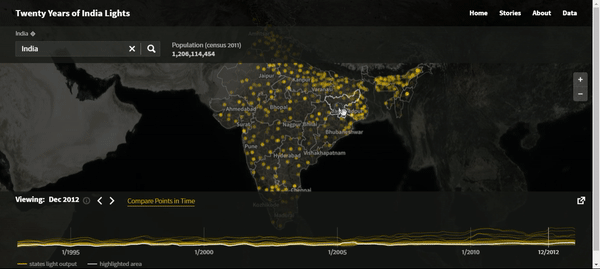Beautiful Satellite Visualisation Reveals Rural India’s Electrification
As India expanded access to electricity over the last two decades, satellites were watching. A new interactive tool lets you explore the roll out.
The country of more than one billion has made a lot of progress with expanding access to electricity. A new visualisation called India Lights shows just how much India has changed.
Researchers at the University of Michigan analysed satellite photos and converted the information into usable data. The interactive map, developed by the World Bank, lets you explore individual administrative areas in India over the past two decades and draws on night-time satellite images collected between 1993 and 2013.
Business Opportunities
More than 300 million people in India still lack electricity to power their households and businesses, and 90 per cent of them live in rural areas. This means they can’t use modern appliances and tools, may have to close up shop early when it gets dark and can’t power digital education tools.
The India Lights website makes it possible to monitor progress on the ground, allowing officials to adjust their policies based on evidence.
But this type of information could also help identify business opportunities for start-ups that provide off-grid solutions to bring electricity to rural areas, bypassing the environmental and economic challenges associated with constructing large-scale fossil-fuel-powered electricity grids.

GIF: Daily Planet
Nano-Grids
Rwanda is one the other countries where researchers are gathering data about night lights. UK-headquartered MeshPower is one of the businesses already supplying solar-powered electricity services to rural communities in this African nation, installing small grids that power fifty families at a time.
Supported by the European Union’s climate innovators at Climate-KIC, the Imperial College London start-up combines nano-grids with smart load and metering systems to provide affordable electricity to villages day and night, even on rainy days.
Originally founded in London by a team of electrical engineers, the company’s Rwanda subsidiary now employs dozens of people and serves thousands of customers in the country.
With the vast majority of growth in energy demand expected to come from developing countries, MeshPower is an example of how business success, economic development and climate change solutions often go hand in hand.
.@ClimateKIC #solar #startup @MeshPower lights up rural #Rwanda with #nanogrid #technology. https://t.co/PocYwoHtfX pic.twitter.com/0oaulgp2a5
— EIT (@EITeu) August 24, 2016
Open Source
The developers behind India Lights note that it is has been difficult to isolate expansion of access to electricity from the broader trend of higher light output across India. They also point out that in rural areas where households are connected to electricity, people may also primarily use electricity for charging phones, running small appliances, and other uses that might not show up on the satellite photos.
The data sets in the World Bank’s application are open source and can be accessed through an API.
Find out how Climate-KIC could help accelerate your start-up.

